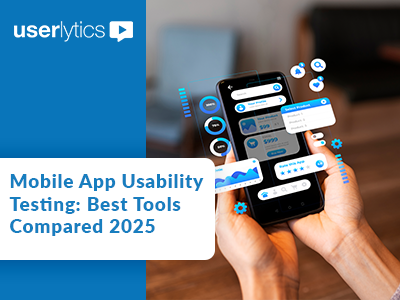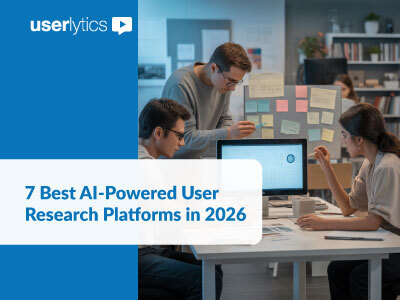Mobile app usability testing has become a cornerstone of successful product development, enabling teams to validate user experiences and optimize app performance before launch. As the mobile landscape continues to evolve, selecting the right usability testing platform can make the difference between an app that thrives and one that struggles to gain user adoption.
The leading mobile app usability testing tools for 2025 are Userlytics, Maze, UserTesting, LookBack, and Testbirds.
Each of these UX testing tools offers comprehensive features designed to help product teams understand user behavior, identify usability barriers, and create more intuitive mobile experiences. By implementing strategic usability testing software solutions, organizations can significantly improve user retention, reduce support costs, and accelerate product-market fit.
Comparison: Top 5 mobile usability testing platforms
| Tool | Best For |
|---|---|
| Userlytics | Highly customizable plans with unlimited accounts/seats and extensive participant management features at competitive pricing |
| Maze | Prototype testing with AI-powered insights and seamless design tool integrations |
| UserTesting | Enterprise-grade user research with comprehensive analytics and extensive participant networks |
| LookBack | Flexible moderated and unmoderated testing with streamlined collaboration workflows |
| Testbirds | Large-scale international testing projects requiring diverse demographic targeting and global reach |
Userlytics
Website: Userlytics
Userlytics stands as a comprehensive remote user testing platform that delivers enterprise-grade capabilities at competitive pricing. The platform provides access to a global pool of over 2 million participants from 150 countries [1], making it an ideal choice for organizations conducting international user research.
Key benefits of Userlytics:
- Exceptional value proposition: Userlytics provides more cost-effective options for large businesses looking to scale usage of UXresearch across the enterprise
- Advanced prototype testing: Test Figma prototypes seamlessly using our no-download recorder, which is particularly advantageous in environments where firewalls restrict extension installations [2]
- Unmatched flexibility: Highly customizable plans, allowing businesses to tailor their packages to specific needs, including unlimited accounts/seats and testing options and extensive participant management features. This flexibility can be particularly advantageous for companies with diverse or evolving testing requirements
- Superior customer support: Userlytics stands out with its best in class customer service and support and largest global footprint
Potential considerations:
- Feature richness: The comprehensive feature set may require initial training for teams new to advanced UX research software
- Credit-based system: Userlytics utilizes a credit system as part of its usage-based pricing plans to offer users a simplified way to utilize features and services across the platform [3]
User testimonial: “Userlytics has been a true game-changer for our testing initiatives. With exceptional customer support, a comprehensive feature set, and top-notch participant quality, they have earned our highest recommendation.” [4]
Userlytics excels in prototype testing and offers seamless integration with popular design tools, making it particularly valuable for design-driven organizations.
Maze
Maze is a comprehensive user research platform that empowers teams to gather actionable insights quickly and efficiently [5]. The platform has built a strong reputation for prototype testing and offers AI-driven analysis capabilities that streamline the research process.
Price: Starting from a free plan for individuals to more advanced options like the Starter Plan and the Organization Plan [5]
Benefits of using Maze:
- Seamless design integration: Maze allows users to validate designs by testing prototypes from popular design tools like Figma, Sketch, and Adobe XD. This feature enables teams to identify usability issues before development begins [5]
- Flexible research methods: Both moderated and unmoderated testing capabilities are available, allowing teams to engage real users in their research. This flexibility helps gather qualitative insights rapidly [5]
- AI-powered analysis: AI-powered research tools, automated analytics for data-informed decisions, and customizable reports [6]
- Rapid deployment: Create and send usability tests in a few clicks. Get closer to your users, capture real insights as they happen, and build better products faster [7]
Drawbacks of Maze:
- Limited enterprise capabilities: Not as robust for extensive, complex research projects [8]
- Pricing barriers: Generally users cite the lack of lower-cost pricing plans as an obstacle for startups, smaller organizations, or any size organization with a tight budget. The average price for a Maze subscription is around $12,000 per month [9]
- Development limitations: While Maze is an excellent tool, it can be a bit overwhelming for beginners. The platform offers a lot of features, and it may take some time to learn how to use them all effectively [7]
Overall, Maze provides strong prototype testing capabilities but may require significant investment for full feature access.
UserTesting
UserTesting operates as a comprehensive usability testing platform focused on delivering in-depth qualitative research through both moderated and unmoderated methodologies. The platform targets enterprise organizations requiring extensive research capabilities and detailed user insights.
Key advantages of UserTesting:
- Extensive participant network: Access to a vast and diverse group of users [8] enables broad demographic coverage
- Advanced analytics capabilities: Advanced analytics tools for detailed insights [8] support comprehensive research analysis
- Versatile testing options: Supports both moderated and unmoderated testing, as well as remote interviews [8]
- Rich insight generation: UserTesting makes it easier to get a diverse array of new tests up and running with more than 100 testing templates. UserTesting also wins when it comes to the depth and breadth of research insights [9]
Limitations of UserTesting:
- Premium pricing structure: UserTesting’s pricing varies based on the number of users and specific features required. Typical annual costs can range significantly, from $16,900 to $136,800 depending on the chosen plan
- Complex learning curve: Complex platform that requires time to fully master [8]
- Potential overcomplexity: May be overkill for simple or small-scale testing needs [8]
- Budget barriers: Pricing can be prohibitive for smaller teams or startups [8]
While UserTesting offers robust enterprise features, organizations should carefully evaluate whether the significant investment aligns with their research requirements and budget constraints.
LookBack
LookBack provides a streamlined approach to usability testing with emphasis on both moderated and unmoderated research capabilities. The platform appeals to teams seeking straightforward workflows without sacrificing essential functionality.
Benefits of LookBack:
- Direct participant engagement: Enables real-time communication between researchers and participants during moderated sessions
- Flexible testing approaches: Supports both guided moderated sessions and independent unmoderated task completion
- Integrated documentation: Built-in video player with note-taking capabilities streamlines insight capture and organization
- User-friendly interface: Simple setup process that doesn’t require extensive technical knowledge
Limitations of LookBack:
- No participant recruitment: Teams must source their own participants or use third-party recruitment services
- Limited advanced features: Fewer sophisticated analysis tools compared to enterprise-focused website usability testing platforms
- Integration constraints: Limited connectivity with other UX research software and productivity tools
- Feature gaps: The platform offers fewer capabilities compared to more comprehensive usability testing software solutions
LookBack works effectively for teams with established participant networks who prioritize simplicity and direct user interaction over advanced analytical capabilities.
Testbirds
Testbirds positions itself as a large-scale testing solution with particular strength in demographic diversity and international reach. The platform serves organizations requiring extensive participant pools and sophisticated targeting capabilities for global user research projects.
Advantages of Testbirds:
- Massive global network: Access to over one million testers worldwide provides exceptional reach for international studies
- Advanced demographic targeting: 65+ demographic filters enable precise participant selection and segmentation
- Enterprise-scale capabilities: Sophisticated features support complex, multi-phase research projects across different markets
- Quality assurance: Professional tester management and quality control processes ensure reliable results
Considerations with Testbirds:
- Premium investment required: Higher pricing structure may exceed budgets for smaller organizations or startups
- Interface complexity: Dashboard navigation and advanced feature utilization require significant onboarding and training
- Overkill for simple projects: Extensive capabilities may be unnecessary for straightforward usability testing needs
Testbirds excels for organizations planning large-scale, international user research initiatives where the extensive capabilities justify the premium investment.
Selecting the Optimal Platform
Userlytics emerges as the superior choice for comprehensive mobile app usability testing
After thorough analysis of the competitive landscape, Userlytics distinguishes itself as the optimal balance of advanced capabilities, competitive pricing, and exceptional flexibility. Userlytics offers more scalable pricing options, allowing unlimited scaling across the enterprise with no change of pricing , making it particularly attractive for growing organizations and established enterprises alike.
The platform’s comprehensive approach addresses critical challenges facing modern UX teams:
Cost effectiveness: It seemed to have the same core features at a fraction of the price [4] compared to premium alternatives like UserTesting
Design workflow integration: The Userlytics platform is compatible with all prototyping platforms including Proto.io, Invision, Figma, Marvel, Axure, JustInMind, UxPin and more
Scalable architecture: Highly customizable plans, allowing businesses to tailor their packages to specific needs, including unlimited accounts/seats and testing options
Global research capabilities: Extensive participant network supporting international studies across diverse demographics and markets
For teams implementing comprehensive remote user testing strategies, Userlytics provides a unified platform that eliminates the need for multiple tool subscriptions while delivering enterprise-grade capabilities at competitive pricing. The platform’s strength in UX analysis and website usability testing makes it particularly valuable for organizations managing both web and mobile user research initiatives.
Whether you’re conducting card sorting studies for information architecture optimization or comprehensive usability testing across multiple devices, Userlytics offers the flexibility and features needed to drive meaningful user insights and product improvements.
Ready to optimize your mobile app user experience? Explore Userlytics’ customizable plans and discover how the platform can transform your user research capabilities.
Citations
[1] https://www.lyssna.com/blog/userlytics-vs-usertesting/
[2] https://userlyticshelp.zendesk.com/hc/en-us/articles/27311680916500-How-To-Use-The-Figma-Integration
[3] https://userlyticshelp.zendesk.com/hc/en-us/articles/20564868390932-How-the-Userlytics-Credit-System-Works
[4] https://www.capterra.com/p/181202/Userlytics/
[5] https://www.spendflo.com/blog/maze-pricing-guide
[6] https://tekpon.com/software/maze/reviews/
[7] https://www.softwareadvice.com/ux/maze-profile/
[8] https://www.lyssna.com/blog/maze-vs-usertesting/
[9] https://www.crazyegg.com/blog/maze-user-testing-review/




